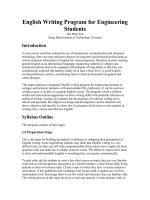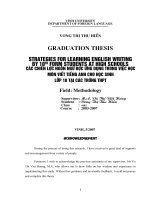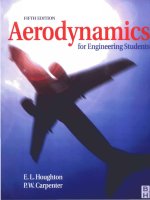English Writing Program for Engineering Students.doc
Bạn đang xem bản rút gọn của tài liệu. Xem và tải ngay bản đầy đủ của tài liệu tại đây (88.15 KB, 8 trang )
English Writing Program for Engineering
Students
Hui Mien Tan
Kung Shan Institute of Technology (Taiwan)
Introduction
As our current world has entered the era of international communication and advanced
technology, there are more and more chances for engineers and technical professionals to
convey technical information in English for various purposes. Therefore, besides learning
general English as an international language, engineering students of colleges and technical
institutes need to be equipped with adequate writing ability so that they can communicate
technical information clearly on at least a basic level. A good English writing proficiency
can be a contributing factor to their professional recognition and career prospect.
This paper proposes a pragmatic English writing program for engineering students of
colleges and technical institutes with intermediate ESL proficiency. It can be used as a
writing course, or as part of a general English course. The program covers a syllabus
outline and instructional approaches on basic writing skills with particular reference to
technical writing. Georges [2] explains that the purposes of technical writing are to inform
and persuade; the subjects are things and development; and its characters are direct,
objective and specific. In short, this is a program which aims to train students in writing
clear, concise and effective English.
Syllabus Outline
This program consists of four stages.
(1) Preparation Stage
This is the stage for building up students' confidence or reshaping their perceptions of
English writing. Some engineering students may think that English writing is a very
difficult task; yet they can still write comprehensibly if they know how to apply the basic
grammar rules and make use of simple, concrete words. The ability to express their ideas in
clear and understandable English is something they can acquire systematically.
To start with, ask the students to write a few short essays on topics they are very familiar
with such as self introduction, description of a family member, a close friend, daily living
patterns or their own chosen topic. Chose a topic in which they have concrete content to
write about. A few guidelines and vocabulary may be provided if students are of a low-
intermediate level. Encourage them to use the words and structures they are familiar with.
The writing process at this stage serves as a warm-up exercise. Let the students work on
something they can easily handle as a way to help them experience some competence in
freely expressing themselves. For the revision part, leave the common errors for the
students to correct themselves by giving indicative symbols or abbreviations, and revise
those awkward expressions. Respond to the content and write encouraging remarks
whenever possible.
(2) Tools Acquisition Stage
Many grammatical constructions are important for writing good English. The principle of
this stage, however, is to let the students first get familiar with a few basic essential tools
that can enhance their sentence clarity in technical writing. Other relevant constructions can
be reviewed if time is available.
A. Use of Subordinate Clauses
Technical writing involves a lot of analytical writing. Subordinate clauses are powerful
tools for analyzing the logical relationships among ideas such as a chronological
development, a cause-effect relationship, a purpose relationship and a condition
relationship.
Students can get familiar with this kind of construction by the following steps. First, briefly
explain the meaning of a subordinate clause. Then give the students a list of complex
sentences. Ask them to identify the subordinate clauses and the subordinating conjunctions,
as well as to explain the relationship expressed in each sentence. The next step is practice.
Ask the students to combine two sentences or a set of isolated ideas into one sentence by
using appropriate subordinating conjunctions. For example:
• New racing bicycles have disc wheels. Wind resistance is reduced. [3]
• Copper is highly conductive. It is used for electric wiring. [3]
• The water is heated. It reaches a pre-set temperature. [3]
• The program was written in FORTRAN.
o It is longer than a machine language version.
o It can run on many different computers. [4]
• Eunice set fire to the cat. The cat jumped into the pool.
The cat could not swim. Rodney rescued the cat. [4]
Finally, ask them to make up their own complex sentences.
B. Use of Relative Clauses
Technical writing often involves detailed definition or modification of a particular term.
Relative clauses can be useful tools for defining and qualifying nouns instead of putting a
long list of technical nouns or adjectives before a noun. In that case, the sentence can be
less confusing. The "where" clause is also useful for describing the location of stages
described in a process.
Similarly, give students a list of sentences that contain clauses introduced by a relative
pronoun. Ask the students to identify the relative clauses and explain their functions.
Examples of restrictive and nonrestrictive clauses should be included for the students to
find out how differently they function. The following type of sentence completing exercise
can help the students understand and apply relative clauses, for example:
• Students ___ are more likely to get good grades.
• Aluminum, ___, is used to make aircraft.
• The new method, ___ ,is faster than the conventional method.
• We like to live in areas ___.
Introduce the possibility of replacing relative clauses by infinitives or participles after the
students have become acquainted with relative clauses.
C. Use of Parallelism
Parallelism is the principle that units of similar content and function should be expressed in
equal form. Repetition of the same structure allows the reader to recognize the ideas more
readily. Long sentences can be made clearer and easier to understand if they are
grammatically parallel. This is also a useful tool when writing comparison and contrast.
Illustrate the concept of parallelism by giving a list of sample sentences, which use
different grammatical constructions like prepositions, conjunctions, clauses, infinitives to
make similar ideas parallel. Then ask the students to practice by rewriting sentences
parallel. For example:
• We are looking for engineers with realistic decision-making capabilities, who can
think logically, and who have the ability to analyze situations carefully. [5]
• It is necessary to communicate well for business, but industry has its needs too, and
government reports and proposals must be well written. [5]
• Advances in technology have made our life more convenient, comfort has been
added to our lives, and safety is also important. [5]
D. Use of Comma and Semicolon
Correct uses of comma can eliminate sentence confusion and avoid misinterpretation of the
intended meaning. Highlight some common rules of using comma, as well as the use of
semicolons in separating two closely related independent clauses in a compound sentence,
and in separating very long phrases or sentences where the use of comma will lead to
ambiguity. Illustrate the uses with examples.
(3) Summary Writing Stage
This stage serves several purposes. First, it works as a transition stage for the subsequent
composition stage. When students write summaries, they can focus more on the practice of
language skills without worrying too much on the content part, provided that the chosen
text is not too difficult to comprehend. In addition, the chosen texts can also serve as sort of
model writing, grammar guides and sources of new vocabulary. Second, summary writing
requires good skills on concise writing; otherwise, only a small portion of the original ideas
can be expressed in a limited number of words. Third, it is appropriate to introduce
paragraph characteristics at this stage as the students have to start writing in paragraphs.
Before they start writing summaries, introduce the following techniques.
A. Conciseness
This is a world of information explosion. The reader has so much to read. Efficiency and
conciseness in informative writing can save personal time and social cost. Concise writing
is a skill, which can be achieved by applying the general guidelines into the writing
practice. They are:
• delete redundant and unnecessary material,
• reduce clauses and phrases to shorter constructions like an adjective phrase or a
single word without losing the needed emphasis.
• eliminate any words or phrases that can be removed without damaging the meaning
of the sentence or paragraph.
Illustrate the general guidelines with example phrases and sentences. Let the students
notice the differences between wordy and concise phrases. Then they can do some
exercises on rewriting concise phrases and sentences.
B. Unity and Coherence
Another learning focus of this stage is to understand paragraph characteristics like unity
and coherence. A paragraph is unified if every sentence in the paragraph is relevant to the
general topic of that paragraph. All sentences should be logically related in one paragraph.
Coherence is achieved by using transition words or phrases, pronouns that refer to nouns in
previous sentences, or repetition of words previously mentioned. Illustrate the effects of
coherence by comparing example paragraphs with coherence destroyed with the ones that
are written coherently. Then ask the students to fill in appropriate transition words missed
in a given text as a practice.
C. How to Write a Summary
Students tend to copy sentences exactly from the original article and put them together
when they write summaries. In that case, they will lose the opportunity in fully utilizing
their practice of writing skills. Furthermore, it is unlikely that they can include all the
important ideas mentioned. A summary should be clear and balanced so that the reader can
grasp the main ideas of the original article without reading it. A better way to make a
summary is to jot down the main points in note form and then link them clearly into
concise sentences in the students' own words. Following that, link the sentences into
coherent paragraphs. Suggest the students to write a topic sentence for each paragraph so as
to help them stay focused on the main idea of that paragraph.. Finally, edit their work and
check if the number of words used is within the stated limit. 150-200 words is a suggested
number for beginners.
Greaney[4] found that students wrote more focused summaries with more complex
sentence structure than they had used in their earlier, longer summaries on the request of
writing the one-sentence summary. As a practice of more complex and syntactically
sophisticated sentences, students may try to write very short summaries approaching the
end of this stage.
(4) Composition Stage
This is the stage where students practice some common patterns of technical writing with
the application of skills taught at previous stages. Topics appropriate to their proficiency
and background are suggested for each type of writing. Students can share some ideas and
vocabulary during group discussion as a pre-writing activity.
A. Write Definitions of Objects
One major method of organizing technical writing is definition, which includes the single-
sentence definition and the extended definition. The single-sentence definition defines an
object by giving the category and the distinguishing characteristics, and it is useful in
defining something concrete. Students can practice the one-sentence definition on a tool or
machine that is frequently used, for instance: a computer, dictionary, watch, electronic
calculator, telephone,or fax machine by using the following schema.
• ___ is a kind /form/category/device/type of (class) that ( distinguishing feature.)
They can also add extra information to write an extended definition. Strategies used to
write extended definitions are use of examples, analogies, description of physical
characteristics, components and functions. Some suggested topics for extended definition
are electricity, television, electric coffee pot, refrigerator, microwave oven, and building.
B. Write a Process
A process is written to instruct or to inform. A clear description of a process involves
sequencing the stages, locating the stages, describing what happens at each stage and
explaining what happens at each stage. Most operational process descriptions follow a
chronological order, which can be shown by using sequence words like first, next then,
subsequently, at this point, later, afterwards, finally and so on. The stages can be located by
using a prepositional phrase " in/at the ......" , or in some cases using a "where" clause to
link a stage, its location and what happens there. For example:
• The warm gas passes through the condenser, where it heats the surrounding and
cools down [3].









